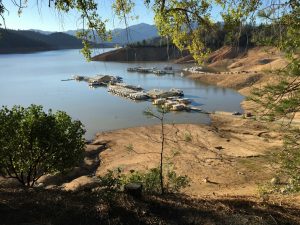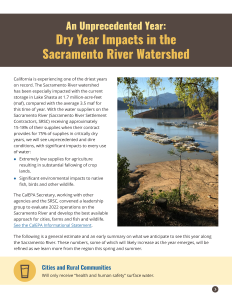California is experiencing one of the driest years on record. The Sacramento River watershed has been especially impacted with the current storage in Lake Shasta at 1.7 million-acre-feet (maf), compared with the average 3.5 maf for this time of year. With the water suppliers on the Sacramento River (Sacramento River Settlement Contractors, SRSC) receiving approximately 15-18% of their supplies when their contract provides for 75% of supplies in critically dry years, we will see unprecedented and dire conditions, with significant impacts to every use of water:
- Extremely low supplies for agriculture resulting in substantial fallowing of crop lands.
- Significant environmental impacts to native fish, birds and other wildlife.
The CalEPA Secretary, working with other agencies and the SRSC, convened a leadership group to evaluate 2022 operations on the Sacramento River and develop the best available approach for cities, farms and fish and wildlife. See the CalEPA Informational Statement.
The following is a general estimate and an early summary on what we anticipate to see this year along the Sacramento River. These numbers, some of which will likely increase as the year emerges, will be refined as we learn more from the region this spring and summer.

Cities and Rural Communities:
Will only receive “health and human safety” surface water.
Fallowed Farmland:
Estimated acreage of all crops fallowed on the west-side of the Sacramento Valley: 370,000 acres of 450,000 in SRSC service area, primarily in Colusa and Glenn Counties.
Economies:
$925,000,000 direct on-farm impact (plus multiplier).
For the rice industry, $251 million direct and induced impacts on rice mills, dryers and suppliers, with more than $76 million attributed to the loss of wages for 1500 jobs.
Fisheries:
Temperature Dependent Mortality for Winter Run Salmon.
Will operate Livingston-Stone Conservation Hatchery for salmon (with capacity to cool water by 10 degrees to assist salmon).
Birds and Wildlife:
National Wildlife Refuges will receive 15-18% of water supplies late in season.
Ricelands are likely to be less than half of average production (Sacramento Valley-wide), significantly affecting food energetics for migratory waterfowl. The concern for potential disease outbreaks is significant as waterfowl will be forced to concentrate on what limited water is available. Reduced water for refuges and extremely limited ability to winter flood ricelands can create the perfect breeding grounds for botulism and avian cholera outbreaks, which can have significant population impacts.
With this challenging year, the water resources managers are working hard to provide limited water for all these important purposes in the most effective way possible. The leaders in the region have also come together and are working with state and federal leaders to seek creative ways to address all of these impacts on our communities and the fish and wildlife that are challenged with a very limited water supply.
If you have additional insights into the Sacramento River watershed that will be helpful to address these issues this year, please share them with info@norcalwater.org.
Click below for more details.




